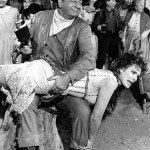
Maranatha’s courtship story has been told and retold in homeschooling circles at least since the 1990s, and is held up by many as an ideal. But there’s one thing that is routinely left out of the story. Just how old was Maranatha Owen when she married Matthew Chapman at the culmination of a parent-guided courtship/betrothal process?
We often think about child marriage as something that happens in other countries, but not here. I’ve generally thought of it that way too, even with my background. I grew up in a conservative evangelical/fundamentalist homeschool community where no one dated and everyone talked about and aspired to courtship. But in my community essentially no one started courting before attaining legal adulthood. Recently I’ve been hearing other stories, though, far different stories—and one of those stories is Maranatha’s, which I will tell in a moment.
There were a couple of relevant reasons those in my community put off courtship. First, courtship was scary, and the consequences were huge. If you courted and then broke it off that had the potential to look really really bad. After all, the whole reason for foregoing dating was the idea that for every romantic relationship you have, you give away a piece of your heart that you will never get back. Second, courtship was about finding a marriage partner, and long courtships or engagements were seen as causes for fleshly temptation. Therefore it made no sense to begin a courtship before you were actually ready for marriage. And thus we waited.
There are some Christian homeschooling leaders, Jonathan Lindvall primary among them, who brush these reasons aside and preach the godliness of youthful courtship. Lindvall argues for avoiding the heartache of broken courtship by means of heavy parental control and what he likes to term “betrothals.” If parents help their children find godly partners, love will follow eventually, or so his argument goes. Lindvall and others like him also argue that young people are ready for marriage far earlier than “the world” may recognize, and that waiting rather than marrying young only leads to temptation and the possibility of going astray.
And now we turn to the story of the 1988 betrothal and marriage of Matthew Chapmen and Maranatha Owen. I will begin by summarizing the story as told by Lindvall, and will then answer the question of the couple’s age.
Having began saved at age 19, Matthew Chapman felt led to the ministry. He attended Baylor University’s ministerial program and began serving as a ministerial intern at a large church in Waco, Texas. During this time he began to look for mentorship from an older man at the church, a homeschooling father named Stan Owen. Stan became Matthew’s spiritual father, and the two spent a great deal of time together. In the summer of 1986, Stan began to feel that God had destined Matthew to marry his daughter Maranatha. Without talking to either Matthew, his spiritual son, or Maranatha, his biological daughter, Stan dedicated the two together in marriage in prayer before God.
In early fall of 1986, Matthew confessed to Stan that he was troubled by a strong attraction to Stan’s daughter Maranatha, confessing that he found her “very attractive” and that she had become “a distraction.” “I don’t know what to do about it,” he said. According to Lindvall’s telling, “Matthew was certain this attraction could not be right since Maranatha was so much younger than he.” “Have you ever considered that this may be a good thing?” Stan asked him in response, “How do you know this isn’t from the Lord?” But Stan went on to tell Matthew that Maranatha wasn’t ready for marriage yet, and that he therefore needed to put a hold on his feelings for a while. Matthew continued to be a frequent guest in Stan’s home, constantly in contact with Maranatha and the rest of the family, but was forbidden to tell Maranatha about his feelings or have any physical contact with her.
Shortly after this Maranatha told her father that she had “an interest” in Matthew. As time went by Maranatha found her “attraction” to Matthew “increasingly distracting.” She told her father about her crush as she had been taught to do. Stan told Maranatha that she needed to “keep her heart pure and focused on the Lord” and to “wholly give herself to the Lord without any lingering desire for Matthew.” And Maranatha obediently sought to do just that. Of course, Stan had already decided to give Maranatha to Matthew, so this was simply a matter of biding his time until he decided Maranatha was ready.
A year later, in early fall of 1987, Matthew felt that God had told him by direct communication that he, Matthew, was to marry Maranatha. Matthew shared with his mentor what God had told him, and asked permission to propose to Maranatha. Stan confirmed that the thoughts may well have been from God, but asked Matthew to wait a little longer, promising to share when he had heard from God himself.
Several months went by and Christmas arrived. Stan’s Christmas present to Matthew was a Christmas card with the words “This year for Christmas, I am going to give you the greatest gift I could ever give you” on the front. Inside was a photograph of Maranatha. There were also instructions: “On January 1st, you may ask Maranatha to marry you.” The instructions stated, however, that while Matthew and Maranatha could become engaged Stan would not give Maranatha to Matthew until he determined she was ready, which might be months or years. Matthew proposed and Maranatha accepted.
Stan wanted to do things as they were done in the Bible, when betrothal was legally binding. Therefore, on February 22, 1988, just over a month after Matthew’s proposal and Maranatha’s acceptance, the two were legally married at the courthouse. Maranatha continued to live in her father’s home until her official “wedding” day, which, although she was already legally married, would be when she would begin her married life.
The summer of 1988, Stan decided that Maranatha was ready. In the six or so months since Matthew’s proposal and Maranatha’s acceptance, Matthew had prepared a home for them to live in and Maranatha had sewed a wedding dress. After dinner one day, Stan unexpectedly and without prior warning informed Matthew and Maranatha that the time was fast approaching. But Stan wanted to reenact the Biblical story of Jesus as bridegroom and the Church as his bride, so he did not give either Matthew or Maranatha a date.
Immediately after Stan’s surprise announcement, Maranatha was taken by her family members to the home of another Christian family. There Maranatha waited for Matthew to come and claim her. Every day between 3 pm and midnight she dressed in her wedding dress and sat with her suitcase, waiting. Finally, at long last, Stan told Matthew that the day had arrived, and Matthew came to the house where Maranatha was staying, claimed her, and took her to a surprise wedding feast Stan had prepared, complete with guests, singing, and dancing. The couple then left on their honeymoon and began their married life.
So now let’s talk ages. When Matthew first expressed his interest in Maranatha—interest Stan affirmed as from God but asked Matthew to put on hold—Maranatha was 13 and Matthew was 26. When Matthew heard from God that he was to marry Maranatha, and begged Stan to let him propose marriage to her, Maranatha was 14 and Matthew was 27. When Stan gave Matthew the go ahead to propose to his daughter, Maranatha was 15 and Matthew was 27. They were the same ages when they married just over a month later, and when Maranatha left her father’s home and the couple began their married life together Maranatha was 15 and Matthew was 28.
The original story doesn’t include any ages at all. I suspect that Lindvall and others felt these ages were appropriate, but were concerned that some might be put off by the idea of a 15-year-old girl marrying a 27-year-old man. I found the ages by looking them up on public record. They’re not available on the internet or in print otherwise.
Marrying girls off so early does several things. For one thing, it precludes them having other options. They have not finished their academic education and are not qualified for anything besides homemaking. And even then, what fifteen-year-old is truly ready to run a home in today’s world? For another thing, such early marriage means a girl marries before she has time to completely mature and form her own outlook on life. But then, sadly, that’s rather part of the point. This sort of arrangement, after all, functions not as an independent adult making her own decisions but rather as a property transfer—and it is explicitly stated as such.
Matthew wrote this in an article titled Thoughts on Betrothal (15 Years Later):
I know that in my case, I cannot even begin to fully communicate the wonderful gift Maranatha’s father gave to me in his daughter on the day we married. All her life, he had called her to trust him and follow him, even when she didn’t understand or, perhaps, even agree with how he was leading her, and she did. A few nights before our wedding feast, when Maranatha was dressed and ready and waiting for me to come, the doorbell rang and it was her dad who showed up instead. He assured her the wedding feast was not that particular night, and asked her to change her clothes and join him for a special dinner. He took her to a nice restaurant where they had a wonderful evening talking and sharing and laughing and crying together. Then, at one point, he told her, “Sweetheart, all your life you have submitted to me, trusted me, and followed me, and you have done this well. But, when Matthew comes and takes you, all of that transfers over to him, even if that means he leads you in ways that vary from how I would do things.” And when I went to get her, she followed her dad’s final lead right into my headship of her. Wow! Did I walk into a good deal or what?! I’ll tell you what though, having a wife with a heart like that makes you all the more want to seek the Lord and lead her faithfully.
Parents, I would also charge you to consider this. The way many Christian homeschooling parents raise their daughters, they mature rather quickly and develop significant capacities by a relatively young age. By their middle-teens, many daughters (but by no means all) possess the maturity and skills to run their own home. My point is to encourage you to be open to the Lord and take to heart that some of your daughters may be ready to marry sooner than your preconceived ideas have allowed for. And why not, if they are truly ready? What is the purpose of holding out for a predetermined numeric age if they are legitimately prepared and the Lord has brought His choice of a young man along for her? Don’t be surprised if this is some of the fruit of your good parenting in bringing forth mature, well-equipped, Godly young daughters. However, I seldom think this will be the case for most young men—it takes them (us) a lot longer to get to where they need to be. I have also seen that, oftentimes, a difference in age—even a significant one—with the man being older, helps make for a better fit.
Matthew says that homeschooled girls mature quickly. While I’m sure there are some homeschooled girls for whom this is true, I know the sort of homeschooled girls he’s talking about—they’re the ones raised to care for big families, cook, clean, and take care of babies, wear long dresses, practice submission, and learn a modest temperament. Maturity isn’t the ability to make a pie or change a diaper. Maturity isn’t the ability to quote a Bible verse or stay silent rather than gushing over the latest fad. And while we’re at it, running a home in today’s world takes more than knowledge of cooking, cleaning, and childcare.
Let me take a moment to address two objections I’ve seen raised. First, it is true that many girls in mainstream society date as early as 14. However, the courtship or betrothal process is closer to actual literal wedding planning than it is to dating. Courtship and betrothal are quite literally about getting married, and not at some nebulous time in the future but now. Second, it is true that it used to be more common for women to marry younger, even as young as 15. However, it was never as common to marry so young as we tend to think it was looking back (in fact, there are entire historical periods where people married just as late as we do today), and besides, the world today is not the same as the world of the past. Average age of marriage is generally a result of societal and economic factors that actually, like, matter.
Maranatha’s story is an extreme, yes, but it is not the only one of its kind. In 2008, only weeks after turning 16, Maranatha’s daughter Lauren married a man who was 26, a man who had already been interested in her for several years. And I’ve been hearing other stories too, stories of courtships begun at age 14 and marriages entered into at 16 or 17. Right now, my heart is sad for girls married off before they have the time to live, to learn who they are, to forge their own beliefs and outlook on life—girls married off so early other options are severely limited, and in such a patriarchal setting that even consent is curtailed.
In case you’re wondering, Matthew and Maranatha were married in Texas. The law in that state requires parental permission for marriages involving those who are 16 or 17, and a special court dispensation for marriages involving those under 16. I suspect that the law was different in 1988, and that this is the reason Maranatha’s daughter Lauren married immediately after turning 16 rather than before. Edit: It appears that Texas changed the marriage age with parental consent from 14 to 16 in 2005 in response to the activities of the FLDS sect moving into Texas and practicing both child marriage and polygamy, and that this explains why Maranatha was able to marry at age 15 while her daughter Lauren had to wait until she turned 16 to wed. Thanks to a reader for the info!














